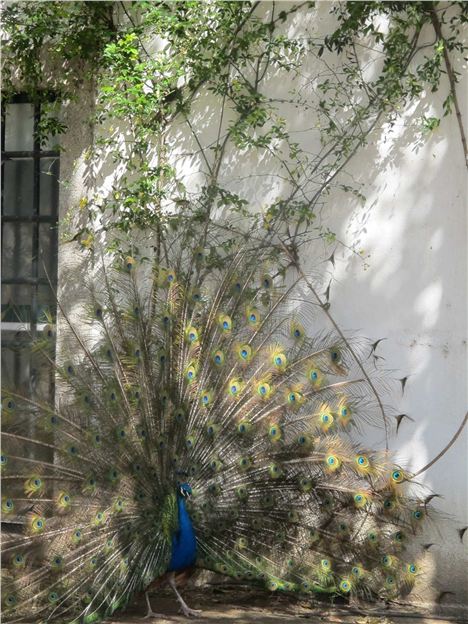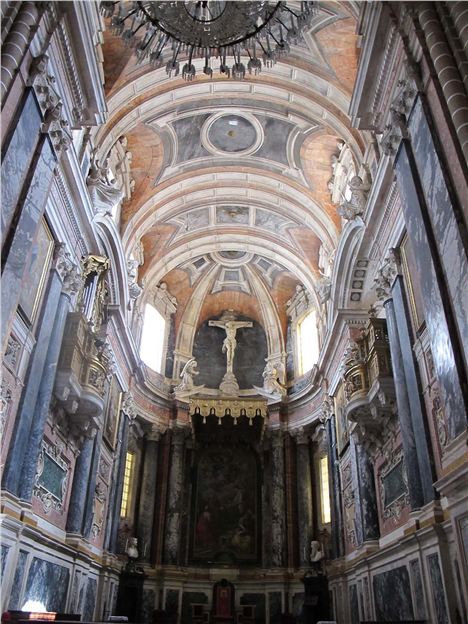IF there’s one must-see in the World Heritage city of Evora it is the Chapel of the Bones in the church of Sao Francisco. It gives a whole new meaning to “skull beneath the skin”. The inscription over the door should see off the squeamish: “Nos ossis qui que acqui estamos pelos voss esperamos (We bones here are waiting for your bones)”. Brace yourself, though, and enter.
 Dem bones, dem bones in the Ossuary Chapel, below
Dem bones, dem bones in the Ossuary Chapel, below
The walls and pillars are constructed from the bones of more than 5,000 monks and nuns. In 15th and 16th century Evora 42 cemeteries took up much-needed room. Solution – centralise in one compact, central space. I can’t quite get my head round those Franciscans artfully constructing an entire chamber out of skulls, tibia and vertebrae. The result is astonishing, but left mortal me in need of a restorative glass of fine, local Alentejo wine.
I can recommend just the place, a short walk through the atmospheric streets of one of Portugal’s great heritage destinations. The Alentejo Wine Route Office on Pr. Joaquim Antonio de Aguiar (www.vinhosdoalentejo.pt) offers complimentary tastings of daily-changing wines. One in every two bottles of Portuguese wine produced comes from the Alentejo region, to the south and east of Lisbon. Its best, showcased here, are among the country’s best.
 Invitation to the Alentejo Wine Trail
Invitation to the Alentejo Wine Trail
One of the delights is how they stick to indigenous grape varieties with exotic names such as Alicante Bouschet, Tricadeira, Roupeiro and (a personal favourite white) Antao Vaz.
I resisted the temptation to work my way through them. Our time in Evora was short – merely a day’s R&R after our epic solitary coastal walk for PLanet Confidential along the Rota Vicentina.
Evora was very different – a kindf of living architectural museum. Like so many UNESCO-protected historic cities, it has benefited from decline in preserving its centre. In this case, its wonderful array of Renaissance buildings was effectively mothballed once the Spanish usurped the throne in 1580 and future Portuguese monarchs preferred to live around Lisbon.
Its history goes back much further – to Roman times. An extraordinary survivor is the Termas Romana (Roman Baths), which feature a circular steam bath 9m in diameter. It has been tricky excavating this find since it is situated underneath the Town Hall.
 Roman Temple, associated with the goddess Diana
Roman Temple, associated with the goddess Diana
More dramatic still are the well preserved ruins of the Templo Romano, with 14 of the original 18 granite columns standing. Erected around 200AD, and associated with the goddess Diana,this hilltop site was later an execution ground during the Inquisition and an abattoir until late in the 19th century.
Nearby are the soaring Se (Cathedral) and 16th century Jesuit University. Both boast outstanding cloisters – the first Gothic, the second a Renaissance version in marble. The university was built in 1558, forced to close in the 18th century and only reopened as a place of learning in the 1970s. It’s free to wander round to admire the elaborate ceilings and azulejo tiles depicting subjects.
Evora seems to possess an inexhaustible array of palaces and churches. Particularly stunning is the great granite Nossa Senhora da Graca church (army-owned, so access is limited), while outside the city walls on the way to the rail station the Ermita de São Brás ("Hermitage of St. Blaise"), resembles a medieval castle, complete with large battlements and gargoyles. It was built in 1485 in thanksgiving for survival from the plague.
 Cataplana – classic pork and clam stew in Mr Pickwick's
Cataplana – classic pork and clam stew in Mr Pickwick's
Humbler corners of this engaging town offer a certain quirky charm. We shared a cataplana, the classic pork and clams dish in a restaurant called Mr Pickwicks, amid Dickens memorabilia, naturally.
It’s just off the pedestrian Rua 5 de Outubro, which winds down from the Temple area to the bustling main square, the Praca do Giraldo. This street is the place to buy souvenirs, notably cork artefacts, from bags to clothing. Sturdy is the word for them. Down a side street where the sun threw deep shadows we ventured into an upmarket saddlers, full of stuffed animals and vintage riding gear.
 Sao Anton Church in Evora's Main Square
Sao Anton Church in Evora's Main Square
Our official guide in all this was Lucia Feltz, a Dutchwoman who has lived on a farm/vineyard 3km outside the city for many years. She and her husband offer agroturismo apartments there – www.monteserralheira.com).
The tour with her concluded in the delightful public gardens near Sao Francisco. Peacocks strutted their stuff outside 16th century Dom Manuel Palace, a riot of Gothic, Manueline, neo-Moorish, and Renaissance styles.
 Peacock display for us outside the Dom Manuel Palace
Peacock display for us outside the Dom Manuel Palace
It was where Vasco da Gama received his commission to command the fleet that would discover the sea route to India. So as Portugal looked to the far corners of the world to garner its wealth, Evuna slipped into its long slumber. Today’s heritage tourists are the beneficiaries.
Fact file
Staying there:
Neil Sowerby stayed at the family-owned Evora Hotel, which offers a double room including breakfast from £65. www.evorahotel.pt. It is a five minute taxi ride/20 minute walk from the old centre but, in return, offers indoor/outdoor swimming pools. on-site parking and fine, airy views of the cityscape.
Getting there:
TAP Portugal (0845 601 0932, www.flytap.com) flies from London Heathrow & Gatwick to Lisbon 9 times daily, with return fares starting at £126 including all taxes and surcharges. Neil Sowerby chose car hire from Guerin. www.guerin.pt/uk/
For more information regarding the Alentejo region of Portugal visit www.visitalentejo.pt/
For more information regarding Portugal visit www.visitportugal.com
Manchester Airport parking:
Neil Sowerby left his car park in T2 Long Stay. Here are all the options:
VIP Valet – drop and collect your car right next to the terminal and get fast tracked through security. Your car is parked on site.
Meet and Greet – drop your car off with staff next to the terminal and collect on your return. Your car is parked on site.
Multi-storey car park at T1, 2 and 3 – ultra-convenient multi-storey car parking right next to the terminal. Park and walk under cover to reach the terminal.
Long stay car park at T1, 2 and 3 – ground surface car park offering free, regular 24 hour bus transfers direct to the terminal.
Shuttle Park – secure parking at great rates for cost-conscious travellers. Free, regular 24 hour bus transfers direct to the terminal.
JetParks – low-cost parking option run by Manchester Airport, fully manned 24/7, parking from £2.99 per day. Visit this link

















